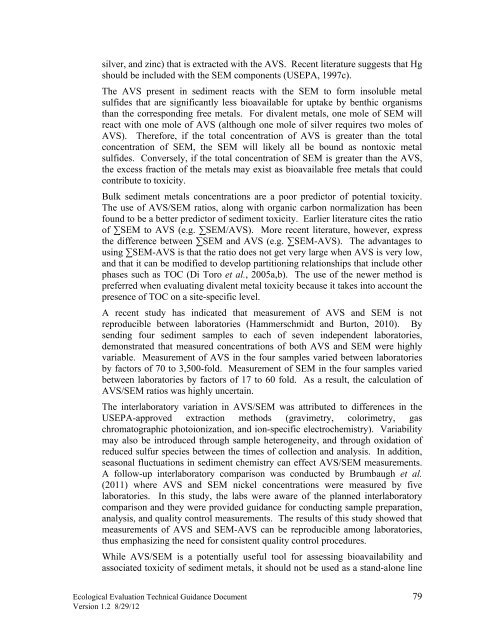Ecological Evaluation Technical Guidance - State of New Jersey
Ecological Evaluation Technical Guidance - State of New Jersey
Ecological Evaluation Technical Guidance - State of New Jersey
- No tags were found...
You also want an ePaper? Increase the reach of your titles
YUMPU automatically turns print PDFs into web optimized ePapers that Google loves.
silver, and zinc) that is extracted with the AVS. Recent literature suggests that Hgshould be included with the SEM components (USEPA, 1997c).The AVS present in sediment reacts with the SEM to form insoluble metalsulfides that are significantly less bioavailable for uptake by benthic organismsthan the corresponding free metals. For divalent metals, one mole <strong>of</strong> SEM willreact with one mole <strong>of</strong> AVS (although one mole <strong>of</strong> silver requires two moles <strong>of</strong>AVS). Therefore, if the total concentration <strong>of</strong> AVS is greater than the totalconcentration <strong>of</strong> SEM, the SEM will likely all be bound as nontoxic metalsulfides. Conversely, if the total concentration <strong>of</strong> SEM is greater than the AVS,the excess fraction <strong>of</strong> the metals may exist as bioavailable free metals that couldcontribute to toxicity.Bulk sediment metals concentrations are a poor predictor <strong>of</strong> potential toxicity.The use <strong>of</strong> AVS/SEM ratios, along with organic carbon normalization has beenfound to be a better predictor <strong>of</strong> sediment toxicity. Earlier literature cites the ratio<strong>of</strong> ∑SEM to AVS (e.g. ∑SEM/AVS). More recent literature, however, expressthe difference between ∑SEM and AVS (e.g. ∑SEM-AVS). The advantages tousing ∑SEM-AVS is that the ratio does not get very large when AVS is very low,and that it can be modified to develop partitioning relationships that include otherphases such as TOC (Di Toro et al., 2005a,b). The use <strong>of</strong> the newer method ispreferred when evaluating divalent metal toxicity because it takes into account thepresence <strong>of</strong> TOC on a site-specific level.A recent study has indicated that measurement <strong>of</strong> AVS and SEM is notreproducible between laboratories (Hammerschmidt and Burton, 2010). Bysending four sediment samples to each <strong>of</strong> seven independent laboratories,demonstrated that measured concentrations <strong>of</strong> both AVS and SEM were highlyvariable. Measurement <strong>of</strong> AVS in the four samples varied between laboratoriesby factors <strong>of</strong> 70 to 3,500-fold. Measurement <strong>of</strong> SEM in the four samples variedbetween laboratories by factors <strong>of</strong> 17 to 60 fold. As a result, the calculation <strong>of</strong>AVS/SEM ratios was highly uncertain.The interlaboratory variation in AVS/SEM was attributed to differences in theUSEPA-approved extraction methods (gravimetry, colorimetry, gaschromatographic photoionization, and ion-specific electrochemistry). Variabilitymay also be introduced through sample heterogeneity, and through oxidation <strong>of</strong>reduced sulfur species between the times <strong>of</strong> collection and analysis. In addition,seasonal fluctuations in sediment chemistry can effect AVS/SEM measurements.A follow-up interlaboratory comparison was conducted by Brumbaugh et al.(2011) where AVS and SEM nickel concentrations were measured by fivelaboratories. In this study, the labs were aware <strong>of</strong> the planned interlaboratorycomparison and they were provided guidance for conducting sample preparation,analysis, and quality control measurements. The results <strong>of</strong> this study showed thatmeasurements <strong>of</strong> AVS and SEM-AVS can be reproducible among laboratories,thus emphasizing the need for consistent quality control procedures.While AVS/SEM is a potentially useful tool for assessing bioavailability andassociated toxicity <strong>of</strong> sediment metals, it should not be used as a stand-alone line<strong>Ecological</strong> <strong>Evaluation</strong> <strong>Technical</strong> <strong>Guidance</strong> Document 79Version 1.2 8/29/12
















